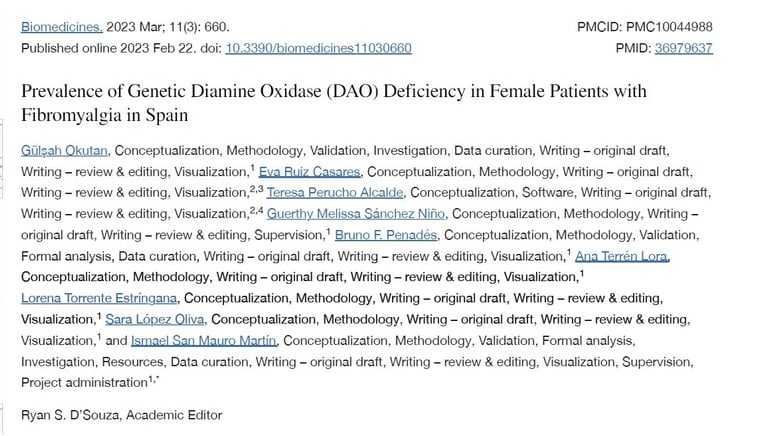Prevalence of Genetic Diamine Oxidase (DAO) Deficiency in Female Patients with Fibromyalgia in Spain
This study, published in the journal Biomedicines in 2023, focuses on the prevalence of genetic deficiency of the enzyme diamine oxidase (DAO) in Spanish women with fibromyalgia. DAO is a key enzyme in the degradation of histamine, an organic compound that plays an important role in the immune system, the digestive system, and the central nervous system. A deficiency in this enzyme can lead to histamine intolerance (HIT), which manifests with various multisystemic symptoms.
SCIENTIFIC STUDIES
Aleti Institute
9/5/20242 min read


Study Objective
The primary objective was to determine the prevalence of genetic DAO deficiency associated with four variants of the Amine Oxidase Copper Containing 1 (AOC1) gene in 98 Spanish women with fibromyalgia. The specific variants studied were: p.Thr16Met (rs10156191), p.Ser332Phe (rs1049742), p.His664Asp (rs1049793), and c.691G > T (rs2052129). In addition, the allelic and genotypic frequencies of these variants were compared with European population samples in Hardy-Weinberg equilibrium (HWE) extracted from the Allele Frequency Aggregator (ALFA) database.
Introduction and Context
Histamine is a compound involved in many physiological functions, and its excess can result in histamine intolerance (HIT), which manifests as respiratory, cardiovascular, digestive, muscular, and neurological symptoms. Fibromyalgia, a chronic disease characterized by widespread muscle pain, has been associated with elevated histamine levels and mast cell activation, suggesting a link between HIT and fibromyalgia. In this context, DAO deficiency may be a relevant underlying factor, as this enzyme is crucial for the degradation of histamine in the digestive tract.
Study Methodology
An epidemiological study was conducted at the Center for Nutrition and Health Research (CINUSA Group) in Madrid, Spain. The sample included 98 Spanish women diagnosed with fibromyalgia, aged between 33 and 60 years. Patients with multiple chemical sensitivity, low histamine diet, treatment with DAO, and severe chronic diseases were excluded. Genotyping of AOC1 gene variants was performed by SNPE Multiplex (Single Nucleotide Primer Extension) followed by capillary electrophoresis. For statistical analysis, Pearson's exact Chi-square test was used.
Main Results
The study found that the prevalence of genetic DAO deficiency was 74.5% in women with fibromyalgia. The specific frequencies of gene deficiency for each variant were 53.1% for p.Thr16Met, 49% for c.691G > T, 48% for p.His664Asp, and 19.4% for p.Ser332Phe. No significant differences were found between the allele and genotype frequencies of women with fibromyalgia and those of the European population in HWE. However, a higher frequency of alleles associated with DAO deficiency was observed in all variants, except p.His664Asp, in the sample of women with fibromyalgia.
Discussion and Conclusions
The results suggest that AOC1 gene variants associated with low DAO activity might be related to fibromyalgia symptoms. Although no significant differences were found in allele and genotype frequencies compared to the European population, a high prevalence of DAO deficiency was identified in women with fibromyalgia, which could contribute to the symptomatology of this disease.
The study highlights the need for further research into the role of AOC1 gene variants in fibromyalgia and their potential as a biomarker for diagnosis and treatment. Furthermore, it underlines the importance of a multidisciplinary approach to treating fibromyalgia, including both genetic evaluation and dietary and supplement interventions.
Limitations and Future Research
Limitations of the study include the relatively small sample size and the lack of a control group without fibromyalgia. The authors suggest that future research should include a larger number of subjects and consider both genetic and serum analyses to better understand enzymatic behavior and its relationship to genetic variants associated with DAO deficiency in the fibromyalgia population.
Final Conclusion
This study provides preliminary evidence of a high prevalence of genetic DAO deficiency in Spanish women with fibromyalgia, which could have implications for the diagnosis and management of this disease. Further research is needed to explore the potential of the AOC1 gene as a biomarker and its impact on DAO enzymatic activity in patients with fibromyalgia.
